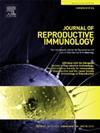子宫内膜异位症与继发性痛经的关系。
IF 2.9
3区 医学
Q3 IMMUNOLOGY
引用次数: 0
摘要
子宫内膜异位症(EMS)是一种常见的妇科疾病,其特征是子宫外存在子宫内膜组织,常导致继发性痛经(SD)、慢性盆腔疼痛和不孕。这篇综述探讨了EMS相关疼痛和SD之间的复杂联系,重点讨论了EMS中痛经的病理生理机制。引起疼痛的主要因素包括炎症、异常免疫反应、神经源性炎症、腹膜刺激、外周致敏、中枢致敏和跨器官致敏。了解EMS中的疼痛通路强调了症状表现的复杂性,并强调了多学科方法管理的必要性。临床表现,包括慢性盆腔疼痛,性交困难,不孕症,胃肠道和膀胱症状,疲劳和不适,讨论,强调EMS对女性健康的不同影响。各种治疗方式,从药物干预到手术和辅助方法,概述了ems相关的经期疼痛/SD的综合管理策略。本综述旨在增进对ems相关的SD的理解和有效管理,最终改善受影响个体的生活质量。本文章由计算机程序翻译,如有差异,请以英文原文为准。
The connection between endometriosis and secondary dysmenorrhea
Endometriosis (EMS) is a prevalent gynecological condition characterized by the presence of endometrial tissue outside the uterus, often leading to secondary dysmenorrhea (SD), chronic pelvic pain and infertility. This review explores the intricate connection between EMS- associated pain and SD, focusing on the pathophysiological mechanisms underlying dysmenorrhea in EMS. Key contributors to pain include inflammation, aberrant immune responses, neurogenic inflammation, peritoneal irritation, peripheral sensitization, central sensitization and cross-organ sensitization. Understanding the pain pathways in EMS highlights the complexity of symptom manifestation and underscores the necessity for a multidisciplinary approach to management. Clinical manifestations, including chronic pelvic pain, dyspareunia, infertility, gastrointestinal and bladder symptoms, fatigue and malaise, are discussed, emphasizing the diverse impact of EMS on women’s health. Various treatment modalities, ranging from pharmacological interventions to surgical and complementary approaches, are outlined to provide comprehensive management strategies for EMS-related menstrual pain/SD. This review aims to enhance understanding and facilitate the effective management of EMS-associated SD, ultimately improving the quality of life for affected individuals.
求助全文
通过发布文献求助,成功后即可免费获取论文全文。
去求助
来源期刊
CiteScore
6.30
自引率
5.90%
发文量
162
审稿时长
10.6 weeks
期刊介绍:
Affiliated with the European Society of Reproductive Immunology and with the International Society for Immunology of Reproduction
The aim of the Journal of Reproductive Immunology is to provide the critical forum for the dissemination of results from high quality research in all aspects of experimental, animal and clinical reproductive immunobiology.
This encompasses normal and pathological processes of:
* Male and Female Reproductive Tracts
* Gametogenesis and Embryogenesis
* Implantation and Placental Development
* Gestation and Parturition
* Mammary Gland and Lactation.

 求助内容:
求助内容: 应助结果提醒方式:
应助结果提醒方式:


